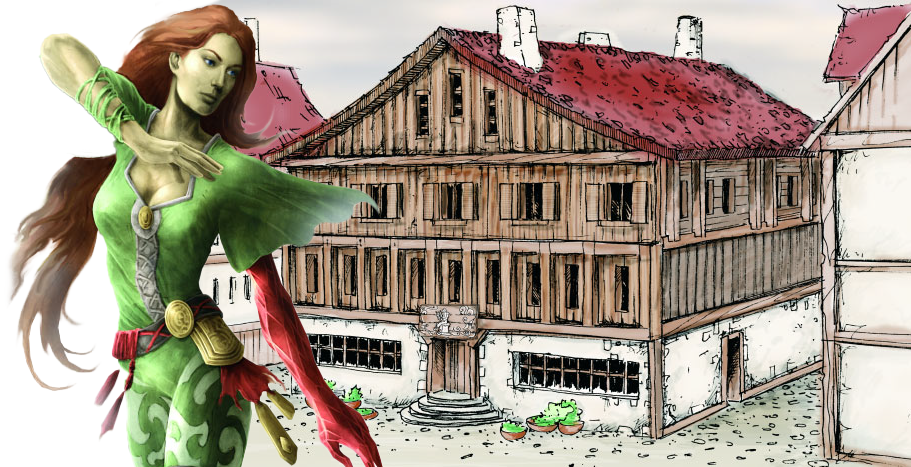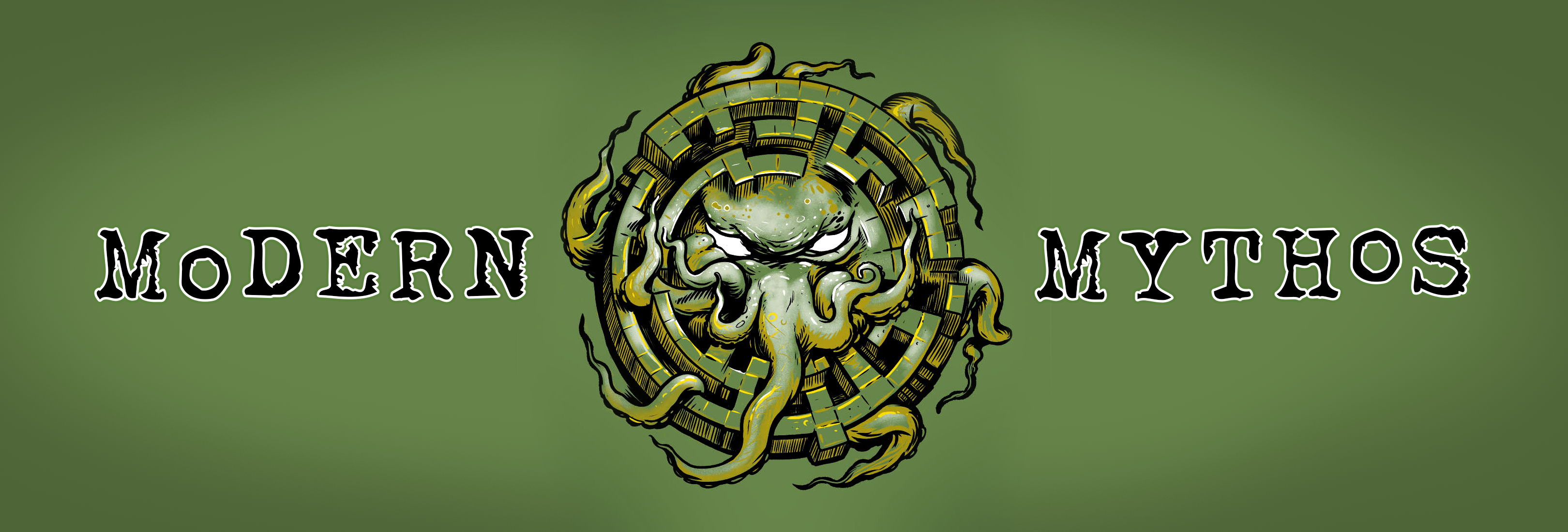DISCUSSING
In the Shadow of the Spire – Session 35C: Ambush in the Banewarrens
“My friends! To arms! To arms!”
“There’s something wrong!” Tee took off running down the hall.
Agnarr and the freshly boot-enhanced Tor both passed her easily in the race out of the Banewarrens. Coming back up the tunnel leading to the antechamber, however, they came up short in front of a wall of seemingly impenetrable darkness. A few moments later, the others caught up to them. Even Tee’s elven vision couldn’t penetrate its unnatural depths. And everything beyond it was eerily silent.
Then Tee heard heavy footsteps approaching them from out of the darkness… but as those footsteps emerged into the passage, there was still nothing to be seen. Tee whipped her dragon pistol up and fired.
The shot missed.
I’ve previously discussed prepping scenario timelines. The short version is that when you have an evolving situation in your campaign and you’re not sure exactly when the PCs will re-engage with it, the best way to prep that situation is often a timeline of upcoming events — e.g., on the 18th the bad guys will rebuild the south wall; on the 19th the bad guys will hire mercenaries to reinforce the compound; on the 20th they’ll hire an assassin to hunt down the PCs; etc.
When the events from this timeline would directly intersect the PCs, I’ll copy the appropriate entry into the Events section of my campaign status document.
Which leads us to the current installment of the campaign journal.
As I mentioned last week in Running the Campaign: Weaving the Background, the events described in this installment of the campaign journal are being driven by this Event:
09/18/790 (11 PM): GQT2 comes to Nibeck Street mansion. (BW Status)
To decode that a bit:
- GQT2 stands for Grail Quest Team 2. The grail quest teams are dispatched by the Pactlords of the Quaan to find the Black Grail (which they believe lies within the Banewarrens). After the PCs wiped out GQT1, the Pactlords assembled a second team to send in.
- BW Status means “Banewarrens Status.” This is a cross-reference to another section of the campaign status document where I’ve collected all of the Banewarrens-related updates, events, etc. (In addition to the GQT2 material in this section, at this time there were also sub-sections tracking the Malignant Crystal, Umber Hulk, and Thought Stalker.)
So this entry is:
- Letting me know that something is happening in the campaign world that might be immediately significant to the PCs. (Because (a) they have an alarm spell in the Banewarrens and/or (b) they might be in the Nibeck Street mansion, Kalerecent’s cave, or the Banewarrens themselves and directly interact with the Pactlords.)
- That there’s additional details about this event that I should reference in “BW Status.”
And if we flip over to “BW Status,” here’s the full entry on the GQT2:
GQT2:
9/18/790 (5 AM): [SPOILER] arranges for Kularas’ escape. Kularas returns to the Belfry.
09/18/790 (11 PM): The GQT2 + Kularas goes to the Nibeck Mansion and scouts carefully, trying to determine if the PCs are present.
- If they are, they’ll pull back to the mansion and lay an ambush (which they’ll flee from quickly if it appears to be going badly). If forced to abandon the ambush, they’ll put a watch on the mansion and then go in when the PCs are known to have left.
- If they aren’t, they all attack Kalerecent and move into the Broken Seal area. They’ll stay in the Broken Seal area until late on 9/19/790, trying to figure out some way through the Sealed Door. They’ll check back every two days until 9/29/790, when they’ll return with another wish spell to open the door (which they’ll go through, knowing that Kikanuile has a ring to get them back out).
If they learn of the Banewarrens’ key from [SPOILER], they’ll start trying to figure out where it might be, too. This will eventually lead them to Alchestrin’s Tomb. (With their resources, they’ll actually know that Alchestrin had the key at one time.)
The last paragraph here are, as you can kind of see, just notes I’ve made about potential future actions of the Pactlords. I haven’t taken time to work these out in detail, however, because I think it’s likely that the PCs will interact with the Pactlords — directly or otherwise — on the 18th, which will change the direction of everything that comes after. (There’s no sense wasting time prepping a bunch of stuff that will just get thrown away.)
So how do you know how far ahead you should prep? Honestly, that’s as much art as science. You’re partly making a best guess about what the players will want to do. (In this case, I think it’s very likely that they’ll be coming back to the Banewarrens sooner rather than later.) And, if in doubt, you can also be guided by how far you think the PCs could conceivably get in the next session. (It’s incredibly unlikely in the In the Shadow of the Spire campaign, for example, that we’re suddenly going to start rushing through multiple days in a single session, so if I have any doubt about how things might turn out, there’s little reason to push a timeline out more than 1-2 days in advance.)
Ideally, though, you’re looking for the event horizon: The point beyond which you know that you can’t see the outcome.
And this session is a great example of exactly WHY you want to find the event horizon: Because the PCs will inevitably blow up your timeline.
BLOWING UP THE TIMELINE
And that’s OK. The reality is that these timelines are designed to be blown up.
In this case, though, I definitely thought I knew how these events were going to play out: I thought it was actually very unlikely that the PCs would be in the Banewarrens at 11 PM when the GQT2 showed up. In their discussions they’d put a little too much faith in their alarm spell to warn them of trouble while they were looking for the Banewarrens’ key and:
- that alarm wouldn’t warn them if Kalerecent was attacked; and
- I already knew they were actually spending most of their time outside range of the alarm
So I figured the outcome here was pretty inevitable: Kalerecent, the lone guardian of the Banewarrens, would be ambushed by the Pactlords, hopelessly outclassed, and killed. Which would be great, because it would leave the Banewarrens unguarded, allowing all the different factions interested in the Banewarrens or about to become interested in the Banewarrens — the Pactlords, the Vladaams, the Church, etc. — to send in delving teams, transforming the dungeon into a dynamic and ever-evolving landscape that the PCs would find altered every time they returned.
I didn’t know exactly when the PCs would figure out that the Pactlords had killed Kalerecent and breached the Banewarrens again (which is why I positioned the timeline event horizon where I did), but I knew where the campaign was headed.
… except, of course, I didn’t.
Because the players looked over their notes, looked at the map of Ptolus hanging on the wall, and abruptly realized what I had realized: The alarm spell has a 1-mile radius, and the Ghostly Minstrel — where they slept at nights — was just outside the range.
They panicked and assumed they were already too late: The alarm had probably already been triggered, Kalerecent was dead, and who knew what terrible things were happening in the Banewarrens.
And so they immediately decamped to go see how bad things had gotten.
Except I looked at my campaign clock: They’d realized their error literally an hour before the Pactlords returned. So they checked in, saw everything was fine, recast the alarm spell, and then… stood around chatting about things.
As a result, they were just a couple rooms away when the Pactlords ambushed Kalerecent and the PCs were able to drive off the Pactlords and save Kalerecent.
THIS CHANGES EVERYTHING
Looking back on this 150+ sessions later, the impact this had on the campaign is kind of mind-boggling to me.
Not only did Kalerecent not die here, as I had felt so sure he would, he’s still alive today. The PCs arranged for other knights of the Order of the Dawn to join him in his watch, and made sure they had the supplies and resources they needed to keep the Banewarrens sealed.
Rather than a multi-party dynamic dungeon crawl (although there’s still a bit of that), the story of the Banewarrens in my campaign has instead largely been a bloody and inventive siege. (With, if I do say so myself, some incredibly clever play on both sides of the table.)
Not only have the defensive forces grown and multiplied, but the decision to bring in more members of the Order of the Dawn tangled the Banewarrens even more deeply into the politics surrounding the schism of the Church.
Eventually some of these knights would actually become PCs played by a second group of players running in tandem with the original group!
Of course, the alternative to all this would have been for me to simply decree:
The next time the PCs come to the Banewarrens, the Pactlords have killed Kalerecent.
A static, linear, guaranteed outcome.
But, honestly, where’s the fun in that?
Campaign Journal: Session 36A – Running the Campaign: Using Rituals
In the Shadow of the Spire: Index





 “Don’t let it eat your brains!” Ranthir cried out in warning.
“Don’t let it eat your brains!” Ranthir cried out in warning.














